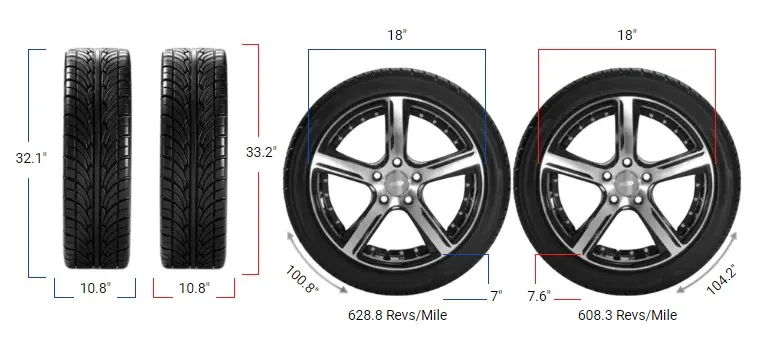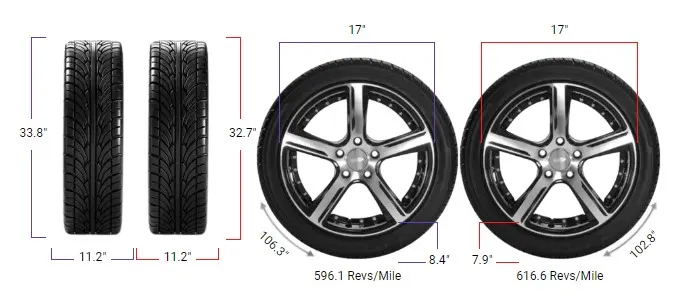Tire Size 215/55r17 vs 225/45r17
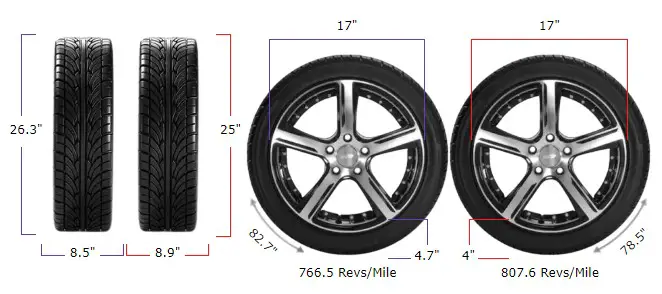
Considering changing your 215/55R17 tires to 225/45R17? Before making the switch, it’s crucial to understand the key differences and potential impacts on your vehicle’s performance and safety. Let’s dive in and explore what you need to know.
- Speedometer will read higher than actual speed, affecting accuracy
- Shorter sidewall may result in a firmer, less comfortable ride
- Wider tread could improve dry handling but reduce hydroplaning resistance
- Reduced ground clearance increases risk of undercarriage damage off-road
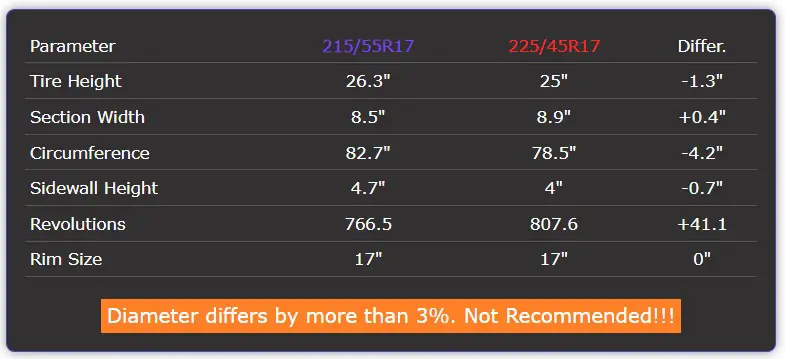
Fitment Guide
In this case, the 225/45R17 tires are 5.1% smaller than the 215/55R17 tires, exceeding the recommended range. Switching to this size is not recommended without making necessary adaptations to prevent rubbing or clearance issues.
On-Road Impact
Switching to a smaller tire diameter can significantly affect your vehicle’s on-road performance. Here are some key areas to consider:

- Speedometer Accuracy: With the smaller 225/45R17 tires, your speedometer will read higher than your actual speed. At a speedometer reading of 20 mph, your actual speed would be 18.98 mph.
- Fuel Economy: The smaller tire size will cause your engine to work harder, potentially reducing fuel efficiency.
- Ride Comfort: The shorter sidewall of the 225/45R17 tires (3.99 inches vs. 4.66 inches) may result in a firmer, less comfortable ride, especially on rough roads.
- Handling: The wider tread of the 225/45R17 tires (8.86 inches vs. 8.46 inches) may provide improved handling and stability in dry conditions but could reduce hydroplaning resistance in wet weather.
Off-Road Impact
If you plan to take your vehicle off-road, consider these potential effects of switching to 225/45R17 tires:
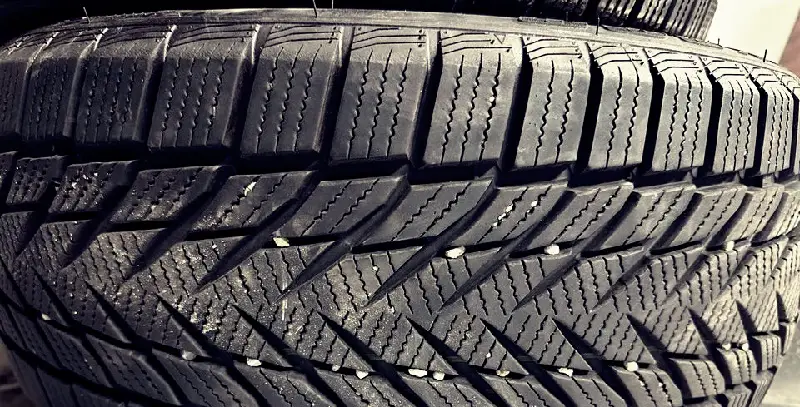
- Ground Clearance: The smaller overall diameter of the 225/45R17 tires will reduce your vehicle’s ground clearance by about 1.34 inches, which could increase the risk of undercarriage damage on rough terrain.
- Traction: The wider tread of the 225/45R17 tires might provide better traction on loose surfaces like sand or gravel but could be more prone to punctures from sharp rocks.
- Durability: The shorter sidewall of the 225/45R17 tires may be more susceptible to damage from impacts and could reduce the tire’s overall lifespan in harsh off-road conditions.
215/55r17 vs 225/45r17
| Feature | 215/55R17 | 225/45R17 | Difference |
|---|---|---|---|
| Diameter inches (mm) | 26.31 (668.3) | 24.97 (634.3) | -1.34 (-34) -5.1% |
| Width inches (mm) | 8.46 (215) | 8.86 (225) | +0.39 (+10) +4.7% |
| Circumference inches (mm) | 82.66 (2099.53) | 78.45 (1992.71) | -4.21 (-106.81) -5.1% |
| Sidewall Height inches (mm) | 4.66 (118.25) | 3.99 (101.25) | -0.67 (-17) -14.4% |
| Revolutions per mile (km) | 766.53 (476.3) | 807.61 (501.83) | +41.09 (+25.53) +5.4% |
| Speedo Reading | 20 mph (32.19 km/h) | 18.98 mph (30.55 km/h) | -1.02 mph (-1.64 km/h) |
What is the Main Difference Between 215/55r17 and 225/45r17 Tires?
The main difference between 215/55R17 and 225/45R17 tires is the overall diameter. The 225/45R17 tires have a diameter that is 1.34 inches (34 mm) or 5.1% smaller than the 215/55R17 tires.
Can I Use 225/45r17 Tires Instead of 215/55r17?
No, using 225/45R17 tires instead of 215/55R17 is not recommended. The 5.1% difference in diameter exceeds the advised range of 3%, which could lead to fitment and performance issues.
How Much Taller is a 215/55r17 Tire Than a 225/45r17?
A 215/55R17 tire is 1.34 inches (34 mm) taller than a 225/45R17 tire. The overall diameter of the 215/55R17 is 26.31 inches, while the 225/45R17 measures 24.97 inches.
How Much Wider is a 225/45r17 Tire Than a 215/55r17?
A 225/45R17 tire is 0.39 inches (10 mm) wider than a 215/55R17 tire. The tread width of the 225/45R17 is 8.86 inches, compared to 8.46 inches for the 215/55R17.
Our Observation
While the 225/45R17 tires offer a slightly wider tread for potentially improved handling on pavement, the 5.1% smaller overall diameter falls outside the recommended range for a safe and compatible tire swap. The smaller size could negatively impact speedometer accuracy, fuel economy, ride comfort, and ground clearance.
For off-road use, the shorter sidewall and reduced ground clearance may increase the risk of tire and undercarriage damage. However, the wider tread could provide better traction on certain surfaces.
Ultimately, we recommend sticking with the original 215/55R17 tire size for optimal performance, safety, and compatibility with your vehicle’s design. If you still wish to switch to 225/45R17 tires, consult a professional to discuss necessary modifications to ensure a safe and proper fit.


